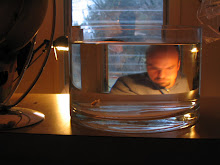 Every now and then, in order to remind myself that there are in fact books that are made of paper, rather than boards, I take Cleo into Barnes & Noble. Usually we end up, in short time, in the back of the bookstore, and I thumb through the choose-your-own-adventure offerings and the atlases designed for middle schoolers while Cleo diligently works her way up and down toy stairs or plays with the sprawling train sets. Last week, though, I paused to look at the tables of recent releases, and found myself face to face with Keith Richards' new memoir, Life. And when I opened it, searching aimlessly for a good anecdote involving a 1960s supermodel or a trashed Parisian hotel room, I was soon rewarded in an unexpected way - with the photo, above. That's Keith, aged four, on his first tricycle, in Southend-on-Sea.
Every now and then, in order to remind myself that there are in fact books that are made of paper, rather than boards, I take Cleo into Barnes & Noble. Usually we end up, in short time, in the back of the bookstore, and I thumb through the choose-your-own-adventure offerings and the atlases designed for middle schoolers while Cleo diligently works her way up and down toy stairs or plays with the sprawling train sets. Last week, though, I paused to look at the tables of recent releases, and found myself face to face with Keith Richards' new memoir, Life. And when I opened it, searching aimlessly for a good anecdote involving a 1960s supermodel or a trashed Parisian hotel room, I was soon rewarded in an unexpected way - with the photo, above. That's Keith, aged four, on his first tricycle, in Southend-on-Sea.Who could have known - and who would have wanted to know - that inside that proud, serious boy was a leering, debauched smack user and blues lover, just waiting to get out? Not I, not I. And, in the same direction: in what way could a beachside ride on a pier produce a Rolling Stone? Eternal questions, in other words: to what degree did the childhood make the man, and to what extent was the man already destined?
They're questions, of course, without full answers - or, rather, with inevitably qualified answers. Environment matters, but so do genes. And yet, despite that, L. and I still find ourselves tracing the lines between ourselves, our house, and our daughter. Is her love of shoes (she'll sit happily, for ten minutes at a time, trying shoes on and taking them off) somehow inherited? Surely not from this half; I haven't bought a pair of shoes, I don't think, since Obama was elected president. But the way she devours bread and beans points straight to me, and strangers claim to see my face in hers. And yet, the way in which she mimics sirens and helicopters clearly, and also a bit sadly, points to the importance of environment. We learn from our surroundings, even if it feels something like a police state.
Or, I'm reminded, if it feels like a mansion. In 1972, the Stones recorded Exile on Main Street, which would become one of their most celebrated albums. They laid down some of the tracks in London, and then rented a sprawling mansion called Nellcote in France, where they lived for several weeks, strewing bottles of bourbon on neoclassical cornices and finishing the album. Years later, Mick Jagger was asked about the degree to which the decadent setting of Nellcote influenced the sound of the record. "It's probably true," he conceded, "that the atmosphere affected the feeling of the music, and the sound of the studio. But you've no idea how much or how little." And then, when asked if he could still tell which portions of the record had been recorded in Nellcote, he added this: "I've no idea which is the Nellcote stuff and which isn't, to be honest."
Which, of Keith Richards' traits, is the tricycle stuff, and which isn't? Which of Cleo's tendencies are my stuff, and which aren't? They're hard questions, and ultimately Jagger's almost certainly right: you've no idea how much or how little. But, that said, the moments in which the lines of influence do seem clear are riveting, if fleeting, and they are powerful in an abiding way.




No comments:
Post a Comment